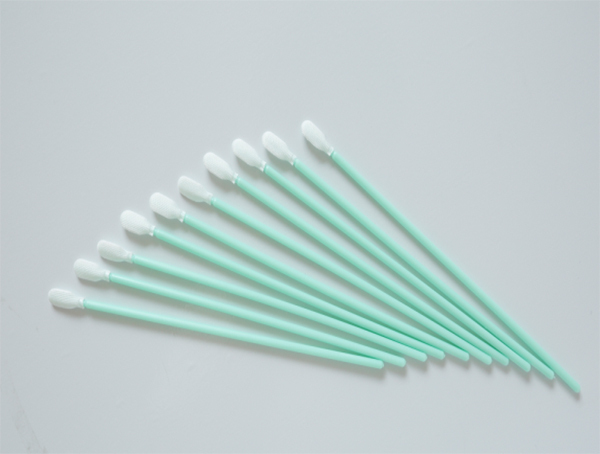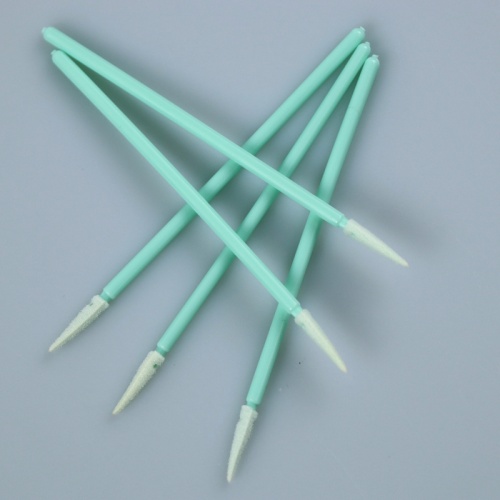The use of high-performance filter can easily reduce the floating particle concentration in the clean Cotton Swab clean room to zero. The actual production site is affected by dust generated by operators, machines, surrounding machines and parts and materials exposed during substrate transportation. Dust, etc. will raise a small amount of particles around the finished product, resulting in particle pollution on the clean surface of the component.

How to use a clean cotton swab to prevent particle pollution in the clean room? The following four basic principles should be observed:
1. Do not carry
The method of cleaning the dust-free room of the cotton swab without particles is as follows:
1) Before the operator enters the clean cotton swab clean room, the machine and parts shall be cleaned before they can be brought in;
2) Personnel entering the clean room with clean cotton swabs shall wear clean clothes, hats and hats made of special conductive fibers that do not produce dust and static electricity in the dressing room. Shoes, gloves, masks, etc.
3) When passing through the air shower room, use high-speed clean air to remove particles attached to the surface of clothes before entering the clean cotton swab clean room.
4) Before machines and materials are brought into the clean room with clean cotton swabs, they should be brought into the clean room with clean cotton swabs in a sealed state as far as possible. Clean the front room with ultrapure water after maintenance, and enter after blowing in the air shower room. Clean the clean room with a cotton swab.
5) In a clean room with clean cotton swabs, you must wear a closed helmet, a belt and a small fan with filter screen.
II. Did not happen
While controlling the amount of dust generated by people in the cotton swab clean room, the amount of dust generated by manufacturing machines, the second largest pollution source, should also be controlled. When the articles are moving, friction and contact peeling will produce dust, and the articles will also produce particles when moving. Therefore, in order to minimize the amount of dust, the following countermeasures should be taken:
1) Form of action to reduce contact and peeling dust;
2) Use low wear and low dust materials;
3) Use low dust generating lubricating oil;
4) The machine adopts the non-contact working principle of air pressure floating.

Three. No reserves
If the "do not bring in" technology can be fully implemented, the cleanliness of the clean room can be maintained with a clean cotton swab. But in reality, the frequent entry and exit of people and things and the movement of manufacturing machines make it impossible to be completely clean in the vast clean room with clean cotton swabs. Therefore, it is very important to quickly apply the "no reserve" technology in the filter to remove the particles that have occurred. Generally, the particles that have occurred will stay on the surface of the surrounding objects according to gravity and electrostatic adsorption. Sudden vibration and unstable airflow will cause these accumulated particles to rise again in the air, increasing the risk of major particle pollution.
In the cleanest room, with the highest level of clean cotton swabs, the air that completely removes particles must flow vertically from the ceiling to the floor at the speed of 0.3-0.4m/s. This is calculated by completely exchanging indoor air and fully filtered air in about 10 seconds. At the same time, the air flow direction must be accurately controlled. In particular, it is necessary to ensure that the air flow channel is unobstructed, because if there are obstacles in the air flow channel, it is easy to produce air air vortex and form an air stagnation area, so that the particles that have occurred nearby cannot enter. It can be discharged quickly and float on a clean cotton swab for a long time without dust. Indoors, some will adhere to the surface of surrounding equipment and cause pollution.
Controlling the air flow can prevent the accumulation of particles, but it can not prevent the accumulation of particles on the charged surface.
In order to prevent particle adhesion caused by electrostatic adsorption, conductive materials with charge levels lower than tens of volts are usually used in the clean room of clean cotton swabs. For the electrification of the finished product itself, the conveying form with low electrification degree and the materials at the contact parts shall be charged by the electrification device.
Four. Exclude / delete
In a machine that cannot avoid a large number of particles, in order to prevent particles from being generated in the clean room of the cleaning cotton swab, direct external exhaust, that is, the so-called local exhaust. Gas. The Countermeasures for exhaust are as follows: due to the need to introduce the same amount of external air, it will be accompanied by a large amount of energy consumption. Therefore, it can not be said to be an absolutely ideal countermeasure. Therefore, while compressing the air volume as much as possible, we should not only discharge it to the clean room of the clean cotton swab, but also consider the Countermeasures of returning the air after particle removal to the clean room of the clean cotton swab.

![]() October 11, 2021
October 11, 2021


